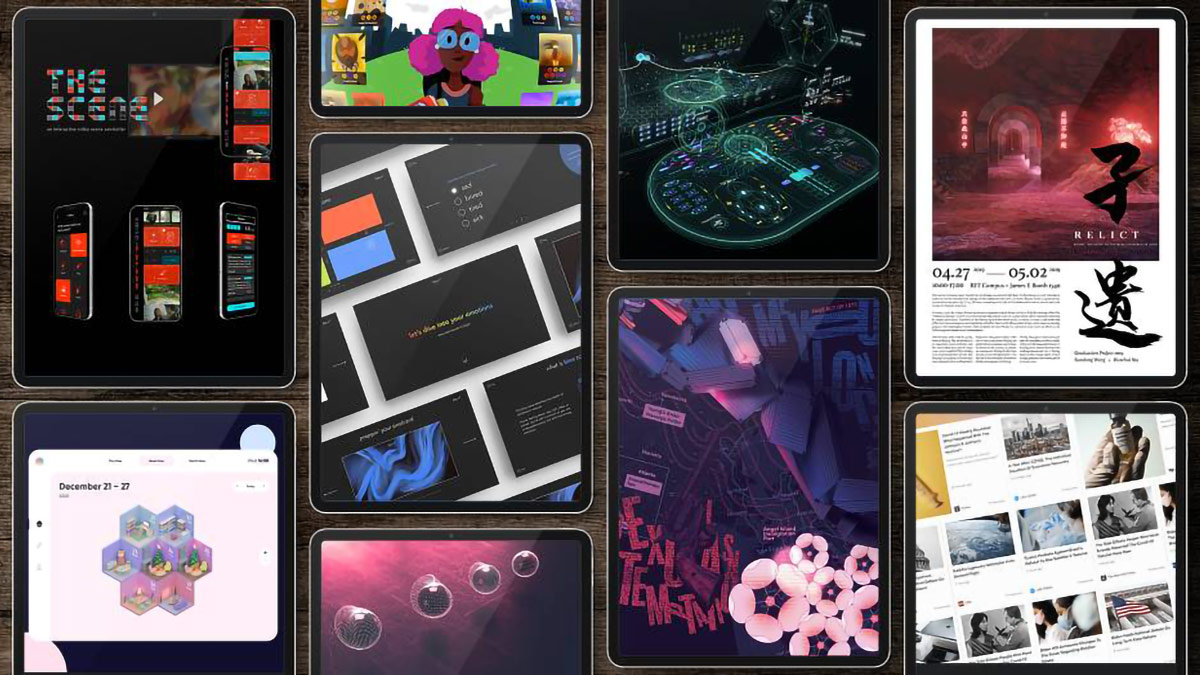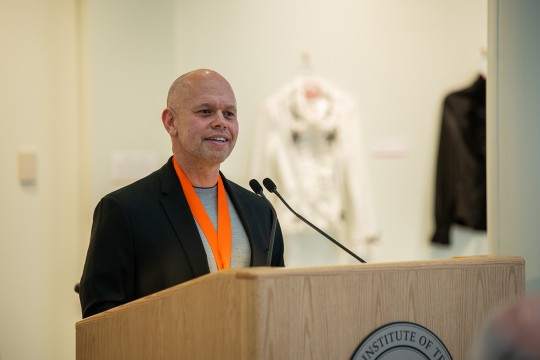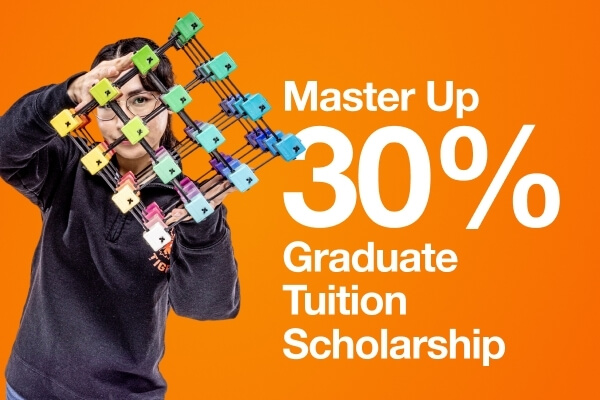Visual Communication Design Master of Fine Arts Degree

Visual Communication Design
Master of Fine Arts Degree
- RIT /
- Rochester Institute of Technology /
- Academics /
- Visual Communication Design MFA
Integrate UX, motion graphics, and 3D design to shape the digital experiences of tomorrow.
Overview for Visual Communication Design MFA
This visual communication degree offers a comprehensive opportunity to investigate the intersection of graphic, interaction, and motion design. You will focus on conceptualizing and creating user-centered design wherever there is a screen or digital experience. This can include mobile phones, automotive instrument panels, medical devices, wearables, and more. This major reinforces the importance of user experience design by combining insight from all areas of design. Choose to focus your studies or combine course sequences from communication design, interaction design, motion design, and design studies. By combining historical, communication and aesthetic theory, principles, and creativity, your work will anticipate design evolution and lead innovation.
The MFA in visual communication design focuses on all areas of design, including graphic design, user experience/interaction design, design studies, motion graphics, and 3D digital design. The changing landscape of people’s everyday interactions has blurred the lines between respected design fields, giving designers new responsibilities to shape experiences. The MFA program embraces this new technology through its curriculum, which addresses these merging skill sets.
An Integrated Visual Communication Design Degree
The MFA in visual communication design provides a learning environment for the advancement in innovative research, user-centered design, and professional practice by focusing on the creative potentials of visual communication through a full spectrum of media. You will advance your design knowledge and technical skills by choosing an option in communication design, interaction design, or motion and 3D digital design.
The cross-disciplinary nature of the program offers a greater potential to foster innovation and creativity in visual communication design. The program reflects the current views and changes occurring in the professional design field. The skill sets required of graphic, interactive, and digital design have now crossed over and are interrelated.
-
Affordable Now. Valuable for Life.
Earn your master’s degree without the full price tag. With Master Up you can receive a 30% tuition scholarship for an RIT master’s degree.
-
Meet us on-campus on February 19
Learn about the programs that interest you. Hear from program faculty, speak with current graduate students, and ask the questions that will help you get one step closer to your career goals.
Careers and Experiential Learning
Typical Job Titles
| Cinematographer and Editor | Game Producer | Graphic and UX/UI Designer |
| Motion Graphic Designer | Product Designer | Senior Visual Designer |
| UI/UX Designer | User Experience Researcher | User Interface Designer |
| UX Designer |
Cooperative Education and Internships
What makes an RIT education exceptional? It’s the ability to complete relevant, hands-on career experience. At the graduate level, and paired with an advanced degree, cooperative education and internships give you the unparalleled credentials that truly set you apart. Learn more about graduate co-op and how it provides you with the career experience employers look for in their next top hires.
Co-ops and internships take your knowledge and turn it into know-how. Co-op in the College of Art and Design provides hands-on experience that enables you to apply your artistic capabilities in dynamic professional settings while you make valuable connections between classwork and real-world applications.
Cooperative education, internships, and other experiential learning opportunities are encouraged for graduate students in the MFA in visual communication design.
Creative Industry Days
Connect with Design Industry Leaders
RIT’s Office of Career Services and Cooperative Education hosts Creative Industry Days, which connects students majoring in art, design, film and animation, photography, and select computing majors with companies, organizations, creative agencies, design firms, and more. Creative Industry Days are a series of events that allow you to network with company representatives and interview directly for open co-op and full-time employment positions.
Featured Work and Profiles
-
Portfolio Showcase
Visual Communication Design MFA students to dive deep into emerging and future design, technology, interaction and motion trends.
Read More about Portfolio Showcase -
From Google to Amazon: Jason Blythe Elevates Digital User Experience
Jason Blythe '02 (graphic design), '05 MFA (visual communication design) has built a successful career in user experience (UX) design, working for major tech companies like Google and Amazon. Now at...
Read More about From Google to Amazon: Jason Blythe Elevates Digital User Experience -
Visual Communication Design Student Work Reel
In this MFA program, students comprehensively investigate the intersection of graphic, interaction, and motion design. Students go on to create user-centered design for screens and digital experiences...
Read More about Visual Communication Design Student Work Reel -
'Creative Collisions' Design and AI Workshop
Students from RIT's new media design (BFA) and visual communication design (MFA) programs collaborated on an annual multi-day design challenge called "Creative Collisions." For the workshop, teams...
Read More about 'Creative Collisions' Design and AI Workshop -
Students and Faculty Featured in Typography Book
A Jordan RIT's presence is widespread in the second edition of Mastering Type, hailed as a crucial guide to typography for print and web design.
Read More about Students and Faculty Featured in Typography Book -
'Creative Collisons' Design Challenge 2023
Students from RIT's new media design (BFA) and visual communication design (MFA) programs teamed up for a three-day design challenge. Each team rapidly developed motion designs, animations,...
Read More about 'Creative Collisons' Design Challenge 2023
Curriculum for 2025-2026 for Visual Communication Design MFA
Current Students: See Curriculum Requirements
Students are also interested in
Admissions and Financial Aid
This program is available on-campus only.
| Offered | Admit Term(s) | Application Deadline | STEM Designated |
|---|---|---|---|
| Full‑time | Fall | Rolling | Yes |
| Part‑time | Fall | Rolling | No |
Full-time study is 9+ semester credit hours. Part-time study is 1‑8 semester credit hours. International students requiring a visa to study at the RIT Rochester campus must study full‑time.
Application Details
To be considered for admission to the Visual Communication Design MFA program, candidates must fulfill the following requirements:
- Complete an online graduate application.
- Submit copies of official transcript(s) (in English) of all previously completed undergraduate and graduate course work, including any transfer credit earned.
- Hold a baccalaureate degree (or US equivalent) from an accredited university or college. A minimum cumulative GPA of 3.0 (or equivalent) is recommended.
- Submit a current resume or curriculum vitae.
- Submit a personal statement of educational objectives.
- Submit two letters of recommendation.
- Entrance exam requirements: None
- Submit a portfolio. View portfolio requirements.
- Submit English language test scores (TOEFL, IELTS, PTE Academic, etc.), if required. Details are below.
English Language Test Scores
International applicants whose native language is not English must submit one of the following official English language test scores. Some international applicants may be considered for an English test requirement waiver.
Duolingo (DET): 130
IELTS: 6.5
LanguageCert Academic: 74
PTE Academic: 60
TOEFL: 88
International students below the minimum requirement may be considered for conditional admission. Deaf and hard-of-hearing test takers with significant hearing loss do not need to take the listening and speaking sections for the TOEFL and IELTS. Each program requires balanced sub-scores when determining an applicant’s need for additional English language courses.
How to Apply Start or Manage Your Application
Cost and Financial Aid
An RIT graduate degree is an investment with lifelong returns. Graduate tuition varies by degree, the number of credits taken per semester, and delivery method. View the general cost of attendance or estimate the cost of your graduate degree.
A combination of sources can help fund your graduate degree. Learn how to fund your degree
Accreditation
Related News
-
November 14, 2025

Blythe takes digital user experience to next level
As a design leader in the tech sector, Jason Blythe has built a career anticipating and enhancing the way in which people use technology to search for information, shop online, and stream sports and entertainment.
-
September 24, 2025

New School of Film and Animation director, faculty roles for 2025-26
Ricky Figueora taking over as the new director of RIT's School of Film and Animation headlines exciting promotions and additions to the College of Art and Design faculty.
-
June 3, 2025

Design MFA program featured heavily in global creative showcase
More than two dozen students from RIT's visual communication design MFA program had creative work selected for the Graphis New Talent Awards 2025, a juried global exhibition of the best and boldest student work in categories of Advertising, Design, Film/Video, Photography, and Print. In total, the students and recent graduates captured 44 awards.
Contact
- Bethany Iraci-McBane
- Assistant Director, Graduate Admissions
- Office of Graduate Admissions
- Enrollment Management
- 585‑475‑5235
- bimges@rit.edu
- Mike Strobert
- Senior Lecturer, Art - Design and Applied Arts
- School of Design
- College of Art and Design
- 585‑475‑5608
- mpsfaa@rit.edu
School of Design






















